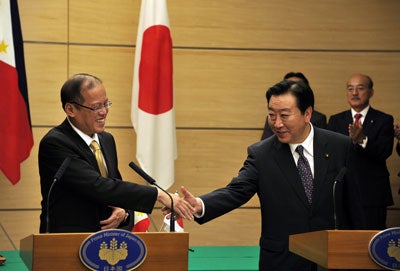Philippine President Beningo Aquino III and Japanese Prime Minister Yoshihiko Noda, who just returned from a week of high-level dialogues at the U.N. headquarters in New York, met in Tokyo September 27 to discuss how they can strengthen their strategic partnership.
Noda and Aquino’s dialogue focused on bolstering their maritime cooperation—specifically, securing freedom of navigation in the South China Sea. At a joint press conference Tuesday evening, Noda expressed a strong desire “to work together in ensuring stability and prosperity in the region” and called attention to the fact that “the Philippines and [Japan] share fundamental values and strategic interests.” Aquino also expressed interest in Japan’s ongoing reconstruction efforts, taking the time to visit the affected areas of the March 11 earthquake. Aquino’s four-day visit to Japan concluded on Wednesday, following a luncheon hosted by Japanese Emperor Akihito.
Their meeting has heightened relevance due to China’s recently increased encroachment into Philippine and Japanese territory. Earlier this year, Chinese vessels erected buoys, buzzed fishermen, harassed Philippine energy survey ships, and even fired live rounds in waters merely miles from the Philippine shore. Such incidents in this area seriously threaten Japan’s trade and energy security, as 90 percent of its imported oil is transported from the Middle East through the South China Sea. In addition, over the past year, Chinese encroachment in the Senkaku Islands (an area claimed by both China and Japan) has nearly doubled, making Japanese officials cognizant of the threat China poses to regional territorial integrity.
China and The Association of Southeast Asian Nations (ASEAN), of which the Philippines is an active member, attempted to quell tensions by passing non-binding guidelines toward implementing the 2002 Declaration on the Conduct of Parties in the South China Sea. However, the Philippines recently criticized these guidelines as failing to address competing territorial claims. With ASEAN’s ineffectiveness in solving regional disputes, President Aquino has since spearheaded a multipronged approach to guaranteeing his country’s territorial integrity—most notably by increasing defense spending, shifting the armed forces’ focus from counterterrorism to territorial defense, solidifying the legal basis behind the Philippines’ plan for joint development in disputed areas, and garnering international support for its position.
Eliciting support from Japan will further bolster Aquino’s case that the ongoing disputes over the South China Sea affect not only the claimant states but also countries like Japan and the United States, necessitating a multilateral solution.
Meanwhile, the U.S. can support the Philippines and Japan’s initiatives by reaffirming its commitment to a multilateral approach in the ongoing disputes, as well as increasing U.S.–Philippines maritime cooperation. President Obama should also demonstrate his support for these efforts by accepting President Aquino’s invitation to visit the Philippines later this year.
Noda and Aquino’s joint statement is a positive step in raising regional awareness on the issue and demonstrating initiative at the executive level. The two heads of state promised to increase bilateral dialogue in various political, economic, and security fields, including augmenting maritime cooperation and initiating a strategic dialogue on security issues. In addition, Japan has committed to strengthening the Philippines “Coast Watch” initiative by increasing training and equipment sharing with the Philippine Coast Guard and initiating high-level reciprocal visits between senior naval officials. Furthermore, Aquino extended an invitation to Noda to visit the Philippines in 2012. However, the two American allies must make a conscious effort to go beyond paying lip service and actually see these commitments fulfilled, if they are to effectively protect our mutual interests in the South China Sea.
